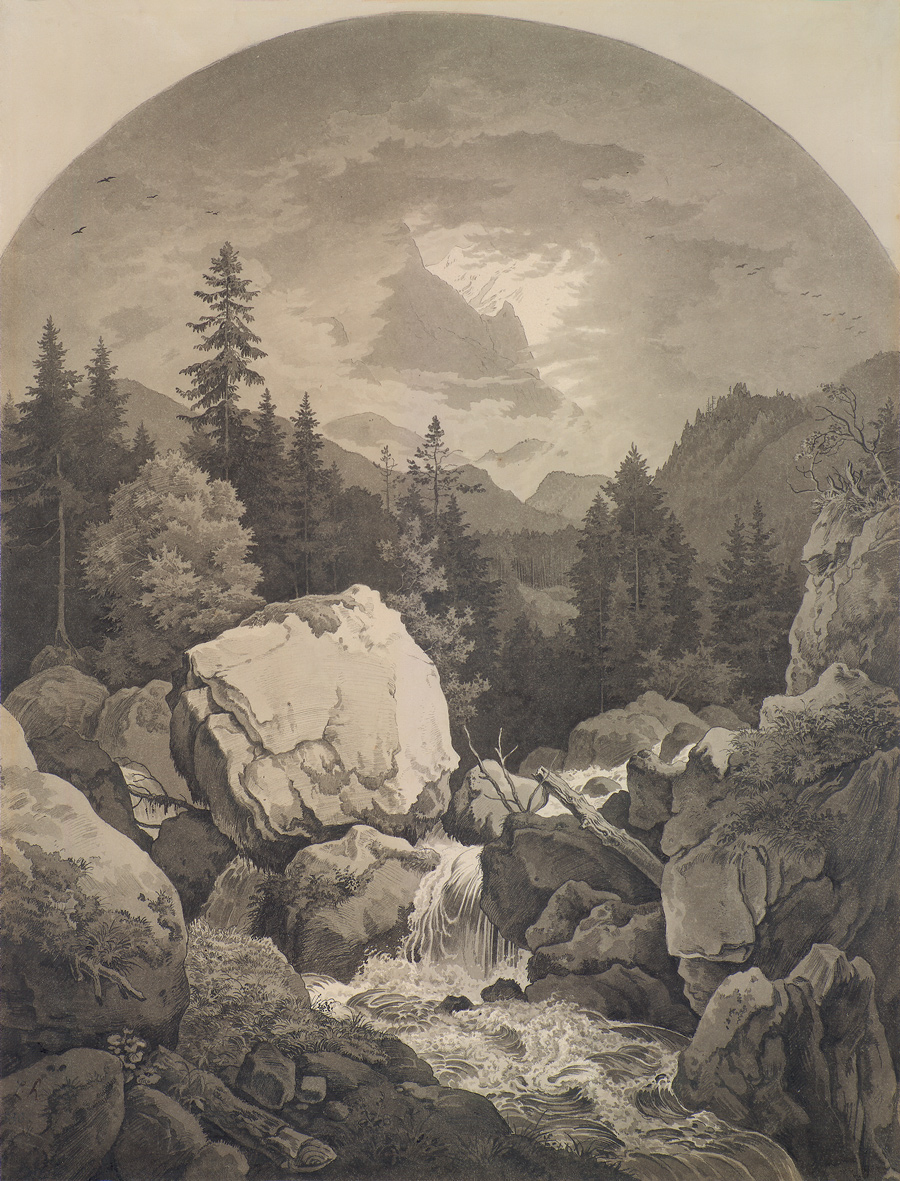Loading the page ...
Carl Wagner
(1796 Rossdorf/Rhön – 1867 Meiningen)
High mountain landscape with torrent. Pen and point of brush in black and gray with gray wash. 44 x 34.2 cm. Monogrammed and dated at lower left: CW (18)30 and with the monogram LR in another hand (for Ludwig Richter).
The painter and landscape etcher Carl Wagner was born in 1796 in the small village of Rossdorf on the Rhön in Thuringia. He received his first education in the fine arts in Meiningen, where his father worked as a secretary to the ducal court and was known as an amateur poet. The foremost German romantic writer Ludwig Tieck was among the guests of this artistic household. In 1817 Wagner went to Dresden where he was to study at the academy until 1820 and where he joined the circle of Johann Christian Clausen Dahl, Carl Gustav Carus, Ernst Ferdinand Oehme, and Ludwig Richter. A stay in Italy between 1822 and 1825 reinforced Wagner’s desire to become a landscape painter. Interestingly enough, Italy did not seem to have a determining influence on Wagner’s further artistic development, as the artist’s early biographer, Andreas Andresen, first noted. Rather the painter seems to have been inspired by the sublime, deserted landscapes of the Swiss and Tyrolean alps, which he depicted in numerous studies after nature. The extensive forests of his central German, Thuringian homeland also served as a rich source of artistic inspiration.
The present large and impressive drawing was executed in 1830 and suggests the artist’s romantic experience of nature. Stylistically it is still characteristic of the work of his early career. At this time Wagner already lived as a court painter and Galerieinspektor (keeper) of the ducal picture collection in Meiningen. In its very careful handling the drawing has a highly finished character and is thus very different from the artist’s other more freely executed sheets of this period. The arched upper border of the drawing, as Helmut Börsch-Supan correctly observes, gives this work a sacred note that is reminiscent of Ludwig Richter’s famous painting of the Watzmann Mountain (1824, Neue Pinakothek, Munich, fig.1). Aspects of Wagner’s composition can be related to this painting, the work of the slightly younger Ludwig Richter, with whom Wagner formed a close friendship while they were in Rome. Both works show a powerful torrent in the foreground, which in our sheet draws the eye to the middle ground, where the pine trees are darkly silhouetted against the bright moonlit night. In contrast to Richter, however, Wagner omitted staffage figures entirely. While Richter shows nature as it is given by god, organized and domesticated by people, as symbolized by the chapel on the ledge on the left and the farmhouse with smoking chimney in the foreground, Wagner’s nature appears relatively sparse and deserted and is absent of any allusion to the divine. As in Richter’s painting, however, two steep mountaintops form the majestic crown of the composition. While Richter’s painting is suffused with a lyric-elegiac mood, which shows the peak of the Watzmann in a soft light, Wagner’s version feels much more theatrical: it is a scene imbued with a deep romantic unease. The two pointed tips of the mountains are hidden behind dark clouds; pale, cold moonlight shines through a gap between the clouds and defines the sharp contours of the mountains.
From the collection Arnold Otto Meyer (Lugt 1994). An expertise by Prof. Helmut Börsch-Supan from March 13, 2004 accompanies the drawing.
